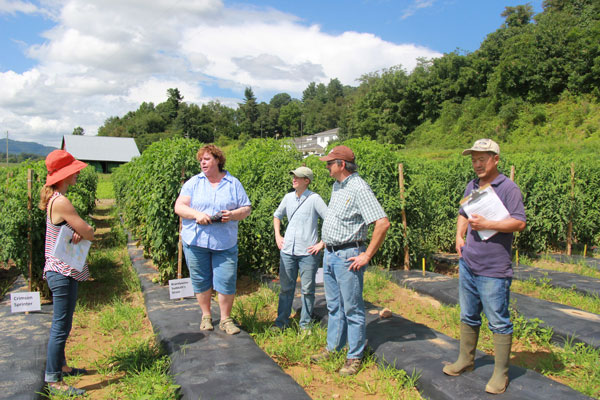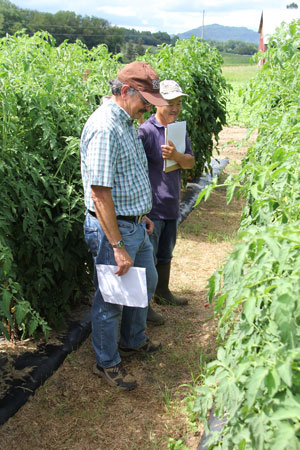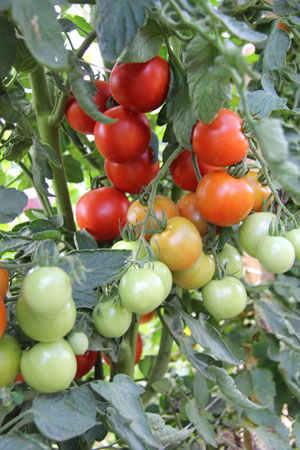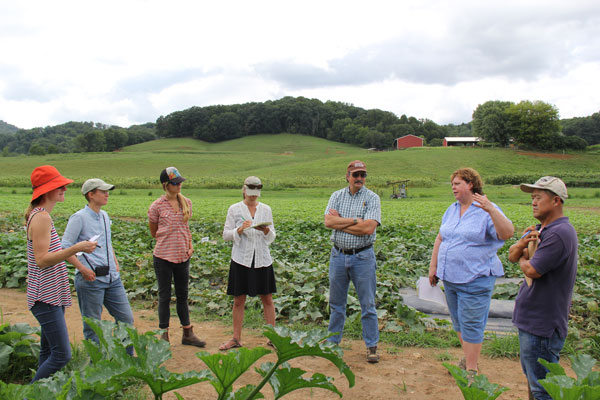by Kiki Hubbard, Organic Seed Alliance | Sept. 29, 2016 –

A number of TOMI project partners discuss variety trials at an NC State research station in August 2016. Pictured above (left to right) Micaela Colley (OSA), Jeanine Davis (NC State), Julie Dawson (University of Wisconsin), Jim Myers (Oregon State University), and Luping Qu (NC State).
The Southeast has made exciting progress in building a regional food system that emphasizes family farming and healthy food. One of the notable areas of growth has been in organic agriculture, and the region continues to see more certified organic farms and acreage. This is a trend that’s national in scope.
But another trend is this: A critical element of organic production and integrity – organic seed – is not keeping pace with this growth. Though we’re making progress in increasing the availability of organic seed (see our report, State of Organic Seed, 2016) supply gaps remain for meeting the diverse and regional needs of all organic farmers. These gaps are especially noticeable to Southeast growers, where pest and disease pressures are high and climates variable. These challenges make the region unique, and there are few seed companies focused on serving this region. Furthermore, most seed companies are breeding crops in chemical production systems, meaning their varieties perform best when coupled with pesticides and fertilizers not used in organic production.
Efforts to fill organic seed gaps in the Southeast go back decades. The Rural Advancement Foundation International (RAFI) based in Pittsboro, North Carolina, has long led initiatives in both policy and farmer education to improve the diversity of seed available in the region. And, in 2003, the Carolina Farm Stewardship Association established the region’s first organic seed project. Saving Our Seeds was a SARE-funded project that delivered a number of seed production guides for farmers and led other initiatives with the goal of increasing the availability of regionally adapted, organic seed.

Jim Myers (Oregon State University) and Luping Qu (NC State) discuss tomato variety trials at an NC State Mountain Horticultural Crops research station. The trials are part of the TOMI project, a multi-state organic plant breeding project focused on improving tomatoes for the fresh market. Photo by Kiki Hubbard.
In 2011, some of the partners behind Saving Our Seeds reconvened to discuss how to continue building an organic seed system in the Southeast (the funding for the project had since ended). They wanted to grow the network of seed stakeholders in the region and create a strategy for collaborative organic seed research and education. Developing such a strategy demanded a deeper understanding of the challenges and needs, so OSA was brought in to lead a seed needs assessment that year after recently completing similar ones in the Pacific Northwest and California.
More than 2,200 individuals responded to the survey – about 500 of them farmers. Just looking at these farmer responses, we found that Southeast growers:
- Rely on saving seed (more than half save seed), demonstrating potential to expand organic seed production in the region through more education and networking.
- Look to other farmers for seed-related questions, underscoring the importance of farmer seed networks, open access to seed, and more seed education.
- See challenges for the organic seed sector, including a lack of availability, dearth of variety trial data, and contamination by genetically engineered crops.
- Want to strengthen their regional seed system, including having access to more organic seed education and research – from seed-saving workshops to data on how varieties perform under organic conditions in their region.
The assessment findings emphasized the need for more attention on organic seed research and education in the region and helped clarify specific priorities. For example, partners used the survey findings to develop research proposals for crops most in need of improvement: cucurbits, tomatoes, and lettuce. In a few short years much progress has been made toward these research goals – all but the third have been funded.
Building a regional seed system requires collaboration among the various stakeholders who make up that system, from plant breeders to seed suppliers to farmers. As mentioned, farmers in the Southeast face unique production challenges, yet the region receives little attention and investment from the private sector. Private seed companies do a lot of things well, but they’re beholden to what’s in the best interest of their shareholders. Investing in crops, markets, and regions that don’t promise a high return doesn’t make financial sense.
That’s where public plant breeding programs come in. Our land grant university system was established to serve the public good first. Public breeders are therefore in the best position to respond to regional research needs that are underserved (or ignored) by the private sector, such as organic agriculture. Fortunately, more public breeding programs are doing just that, including North Carolina State University. NC State is a partner in at least three organic plant-breeding projects currently underway, including the Tomato Organic Management and Improvement (TOMI) project, Eastern Sustainable Organic Cucurbit (ESOcuc) project, and RAFI’s Breeding for Organic Production Systems (BOPS).

Tomatoes ripening at the NC State Mountain Horticultural Crops research station as part of the TOMI project
TOMI is a participatory plant-breeding project that grew out of the Southeast seed needs assessment, where survey participants identified tomatoes as an organic breeding priority. (Tomatoes were identified as a priority in national assessments as well.) TOMI is working to address the growing demand for organic, fresh-market tomatoes that have superior flavor and resistance to important diseases, including late blight, early blight, and Septoria leaf spot. The research team represents multiple states and includes experts from NC State, NC A&T State University, Oregon State University, OSA, Purdue University, and the University of Wisconsin-Madison. The project goals include:
- Identifying existing, and breeding new, varieties that perform well under organic conditions and ensuring farmers have access to both the trial data as well as improved varieties;
- Identifying safe and effective fungicide and/or biopesticide combinations that control pathogens without negatively impacting soil quality or human health, and that are allowed under organic regulations; and
- Furthering the science and practice of participatory plant-breeding methods, which require a close collaboration between farmers and formal plant breeders and other researchers to ensure project outcomes are relevant and useful.
TOMI is an excellent example of collaborative research in the public sector that is responding to the organic seed needs of farmers both regionally and nationally. Multiple partners leverage each other’s expertise in addition to the environmental conditions and climates in their respective regions. For example, NC State conducts most of the variety trials because disease and pest pressures are high in its region. Farmers in other regions then benefit from the selection that takes place there, because other breeders involved in the project can take that improved material and further adapt it in, say, Oregon.
Seed work is ongoing, and the potential for using classical (field-based) plant breeding to address the ever-changing needs in agriculture is limitless. Consider that we enjoy the food crops we have today because of the work of farmers and plant breeders who came before us. In the case of TOMI, the most useful breeding material in this project came from varieties developed by NC State breeder, Randy Gardner, now retired, whose work at the university goes back to the early 1980s. His material has the best disease resistance because of the public investments in his regional breeding program over the course of decades. This is called the long-arc of breeding, and it’s essential to the future of seed and food.

This is the NC State Mountain Horticultural Crops research station based outside of Asheville. In the forefront are organic cucurbit trials as part of the ESOCuc project, a multi-state organic plant breeding project. Also pictured are the TOMI project variety trials focused on improving organically produced tomatoes for the fresh market.
Moving forward, the sustainable agriculture community needs to be active (and loud!) in policy discussions that aim to reinvigorate public plant breeding programs. While it’s exciting to see more land grant universities interested in organic plant breeding, this public infrastructure is at the same time crumbling. In the last 20 years, we’ve lost more than 30% of our public plant breeding programs.
The Seeds & Breeds Coalition for 21st Century Agriculture held a summit in 2014 to sound the alarm and create a plan for reversing this trend. Participants gathered to develop a policy platform to support and grow our nation’s public plant breeding programs. The proceedings from the summit are already informing Farm Bill requests and prompted an intellectual property rights meeting this past August that focused on keeping seed coming out of public breeding programs in the public domain – no restrictions on seed saving or further research.
Keep tabs on these and other seed policy efforts by joining the newsletters and social media channels of the National Sustainable Agriculture Coalition, National Organic Coalition, and Organic Seed Alliance. And remember this: Seed is the embodiment of potential, of change. The more of us that show up and nudge evolution – be it in the field through selection or in policy work with a phone call – the faster and more impactful that change will be.


